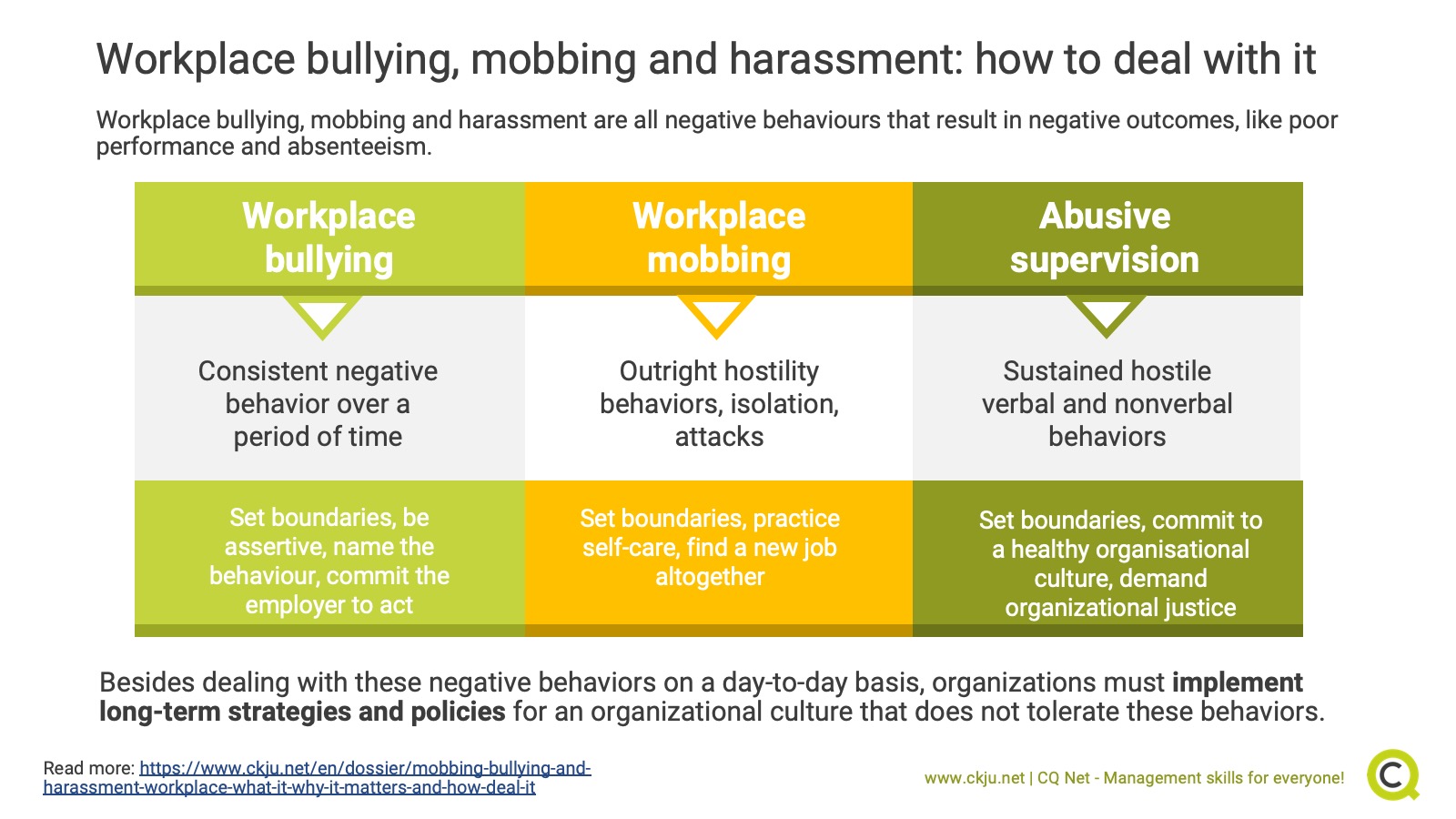- All Management Learning Resources
- Mobbing, bullying and harassment

Executive summary
This CQ Dossier describes workplace bullying, mobbing, and abusive supervision and the impact of these negative factors on individiuals and organizations. We also provide examples of the behaviors associated with it and give recommendations on how individuals, firms and other organizations can deal with bullying, mobbing and harassment at work.
Contents
- Executive summary
- Bullying, mobbing and abusive supervision are distinct constructs
- Workplace bullying means undermining the individual
- Workplace mobbing means hostility towards individuals or groups
- Abusive supervision
- Conclusion
- Critical appraisal of Bulling, Mobbing and Abusive supervision: Solidity rating 5
- Key take-aways
- References and further reading
Bullying, mobbing and abusive supervision are distinct constructs
The following dossier provides descriptions of bullying, mobbing and abusive supervision. The three constructs are similar yet distinct. They are similar in that all three involve negative behavior towards an employee that results in negative outcomes, such as poor performance and absenteeism.
They are distinct in that workplace bullying can originate from either a supervisor or peer towards an employee, yet abusive supervision originates from the leader. Moreover, workplace bullying and abusive supervision is typically one individual against another. Workplace mobbing is a multi-level phenomenon and typically occurs when a supervisor ‘whips up’ a group of subordinates to bully another subordinate.
Workplace bullying means undermining the individual
Workplace bullying is when an employee experiences consistent negative behavior over a period of time (Branch & Murray, 2015). A single episode is not enough to warrant the behavior as bullying. Workplace bullying includes verbal and non-verbal communication abuse, psychological tactics to undermine the individual such as gaslighting, physical abuse, and humiliation (Rayner & Cooper, 2006).
Unlike school bullying, workplace bullies are typically in positions of power and can justify their actions through the formal policies and procedures of the organization. It is important to note that there have been examples of peers and subordinates who bully their supervisors; however, the majority of workplace bullies are typically in a supervisory position (Rayner & Cooper, 2006).
Workplace bullying can take many direct and indirect forms
There have been several cases of workplace bullying documented by the media. One large case recently reported by the Willamette Week described how a supervisor physically harassed his subordinates through pelting them with objects from an air-compressor gun. The harassment lasted for six years and there was little done to discipline the supervisor. In fact, one of the employees who complained lost his job.
Workplace bullying can be obvious to many or can be secretive and overlooked by senior management. Workplace bullying can also come in the form of micro-management, criticism, and stopping promotions (Rayner & Cooper, 2006).
Workplace bullying leads to negative outcomes
There are several negative outcomes related to workplace bullying. At the individual level, workplace bullying is related to physical and pychological health problems, including PTSD, burnout, intentions to leave the organization, and reductions in job satisfaction and organizational commitment (Nielsen & Einarsen, 2012). Moreover, workplace bullying is related to mental health issues over a long period of time (Nielsen & Einarsen, 2012). Workplace bullying can also impact employees who witness the victimisation and can lead to declines in employee morale (Ramsay, Troth & Branch, 2011).
How to deal with workplace bullying?
There are several ways to deal with workplace bullying. If the workplace bully is in a supervisory role, then the organization must develop and implement strategies and policies that thwart bullying behavior. To ignore or to be laissez-faire in dealing with workplace bullying can lead to a change in organizational climate whereby senior management support or tolerate workplace bullying ( Rayner & Cooper, 2006). There are also actions that individuals can take to deal with workplace bullies.
The Workplace Bullying Institute suggest several actions to take including taking time off to heal and to launch a counterattack whereby the individual ‘names’ the behavior and also calls out the bully. Being assertive in stating that you are a victim of workplace bullying can compel your employer to take action.
In terms of strategies to avoid being bullied, it is important that at the first sign of bullying behavior you state that you won’t tolerate this kind of behavior. Secrecy and silence create environments for bullies in which to thrive. Through speaking out and being assertive, the bully will lose their power.
Workplace mobbing means hostility towards individuals or groups
Workplace mobbing is defined as hostile behaviors that are directed from individual to individual as well as from group to individual (Steffgen, Sischka, Schmidt, Kohl & Happ, 2019). The behaviors include (Steffgen et al., 2019):
- attacks,
- isolation,
- hostile interactions, and
- physical violence or threats.
There is usually a particular intention behind workplace mobbing
Workplace mobbing can occur on an individual level whereby one person bullies another and can also occur at the group level, whereby a group bully an individual. Other scientists have distinguished workplace mobbing from workplace bullying as a tactic used by bullies to enlist coworkers to attack an individual (Henshaw, 2018).
Researchers have also shown that workplace mobbing is prevalent in certain industries such as health sciences, and academia. In one particular troubling case of workplace mobbing, a neurologist at McGill University committed suicide after experiencing mobbing when she was accused of violating ethical procedures (Seguin, 2016).
Workplace mobbing has seriously detrimental effects on job and life satisfaction
Workplace mobbing can lead to decreases in job and life satisfaction and can affect employee health and well-being. This can also have a negative impact on the organization as they deal with productivity losses due to sickness and other health issues (Nielsen & Einarsen, 2012). Moreover, over time victims of mobbing tend to quit the organization.
How to deal with workplace mobbing?
Henshaw (2018) suggests practicing self-care if you are a victim of mobbing. However, she also cautions that sometimes it is difficult to survive in an organization that support workplace mobbing, so sometimes it is best to find a new job.
Management skills newsletter
Join our monthly newsletter to receive management tips, tricks and insights directly into your inbox!
Abusive supervision
Abusive supervision is the “sustained display of hostile verbal and nonverbal behaviors, excluding physical contact” (Tepper, 2000). Research on abusive supervision has shown it is related to several negative outcomes (Tepper, 2000; Mackey, Frieder, Brees & Martinko, 2017):
- lower organizational commitment,
- psychological distress, and
- lower job satisfaction.
Abusive supervisors often use workplace bullying tactics
Abusive supervision overlaps with workplace bullying because abusive supervisors use bullying tactics to undermine their subordinates (Mitchell & Ambrose, 2007). Abusive supervision can also thwart knowledge sharing, which is important for firms to gain a competitive advantage (Wang & Noe, 2010).
Abusive supervision can lead to emotional exhaustion
A recent study found that abusive supervision has a negative impact on knowledge sharing because those who are abused experience emotional exhaustion (Lee, Kim & Yun, 2018). However, the study also found that when employees perceive their organizations as champions of organizational justice, this weakens the effects of abusive supervision (Lee et al., 2018).
Toxic or destructive leadership can faciliate abusive supervision
Toxic or destructive leadership is connected to negative personality traits such as narcissism, psychopathy, and Machiavellianism, referred to as the “Dark Triad” (Paulhus & Williams, 2002). Especially leaders high in Machiavellianism tend to put their desire to gain control and power over others above everything else. Abusive supervision is one means to achieve this goal. Wisse and Sleebos (2016) found in a recent empirical study that position power strengthens the connection between Machiavellianism and abusive supervision.
How to deal with abusive supervision?
Consequently, it is important that organizations have a culture that is based on concern for others and have policies that reflect the elements of organizational justice: distributive, procedural and interpersonal justice.
Conclusion
Workplace bullying, mobbing and abusive supervision can have deleterious effects on both the individual and organization. It is vital for organizations to have policies and procedures in place that challenge these negative behaviors so that individuals can thrive and be productive.
Critical appraisal of Bulling, Mobbing and Abusive supervision: Solidity rating 5
Based on the empirical evidence for the evidence of bullying, mobbing and abusive supervision on organizational outcomes, this dossier is assigned a Level 5 rating (based on a 1- 5 measurement scale). A level 5 is the highest rating score for a dossier based on the evidence demonstrating that these negative behaviors can impact both individual and organizational effectiveness. To date, the research on all three constructs has demonstrated that they can have a negative impact on both the individual and the firm.
Key take-aways
- Workplace bullying is when an employee experiences consistent negative behavior over a period of time
- Workplace mobbing is defined as hostile behaviors that are directed from individual to individual as well as from group to individual
- Abusive supervision is the “sustained display of hostile verbal and nonverbal behaviors, excluding physical contact”.
- Workplace bullying, mobbing, and abusive supervision all have negative impacts
- Organizations must develop and implement strategies and policies that thwart bullying behavior
References and further reading
Branch, S., & Murray, J. (2015). Workplace bullying. Organizational Dynamics, 44, 4, 287-295.
Henshaw, S. (2018). Bullying at Work: Mobbing is on the rise. Article retrieved from: https://psychcentral.com/blog/bullying-at-work-workplace-mobbing-is-on-the-rise/
Lee, S., Seckyoung, L. K., & Yun, S. (2018). A Moderated Mediation Model of the Relationship between Abusive Supervision and Knowledge Sharing. The Leadership Quarterly, 29, 3, 403-13.
Mitchell, M., & Ambrose, M. L. (2007). Abusive supervision and workplace deviance and the moderating effects of negative repicrocity beliefs. Journal of Applied Psychology, 92, 4, 1159-1168.
Nielsen, M. B., & Einarsen, S (2012) Outcomes of exposure to workplace bullying: A meta-analytic review, Work & Stress, 26, 4, 309-332, DOI: 10.1080/02678373.2012.734709
Paulhus, D. L., & Williams, K. (2002). The dark triad of personality: Narcissism, Machiavellianism, and Psychopathy. Journal of Research in Personality, 36, 556–568.
Ramsay, S., Troth, A. & Branch, S. (2011), Work‐place bullying: A group processes framework. Journal of Occupational and Organizational Psychology, 84: 799-816. doi:10.1348/2044-8325.002000
Rayner, C., & Cooper, C. L. (2006). Workplace Bullying. In Kelloway, E., Barling, J. & Hurrell Jr., J. (eds.), Handbook of Workplace Violence (pp. 47-90). Thousand Oaks, CA: Sage.
Seguin, E. (2016). Academic mobbing, or how to become campus tormentors. Article retrieved from: https://www.universityaffairs.ca/opinion/in-my-opinion/academic-mobbing-become-campus-tormentors/
Steffgen, G., Sischka, P., Schmidt, A.F., Kohl, D & Happ, C. (2019). The Luxembourg Workplace Mobbing Scale. European Journal of Psychological Assessment, 35, 2, 164-71
Wang, S., Noe, R. A. (2010). Knowledge sharing: A review and directions for future research. Human Resource Management Review, 20, 115-131
Kiazad, K., Restubog, S. L. D., Zagenczyk, T. J., Kiewitz, C. and Tang, R. L. (2010) ‘In pursuit of power: The role of authoritarian leadership in the relationship between supervisors’ Machiavellianism and subordinates’ perceptions of abusive supervisory behavior’, Journal of Research in Personality, vol. 44, no. 4, pp. 512–519.
Wisse, B. and Sleebos, E. (2016) ‘When the dark ones gain power: Perceived position power strengthens the effect of supervisor Machiavellianism on abusive supervision in work teams’, Personality and Individual Differences, vol. 99, pp. 122–126.
About the Author



